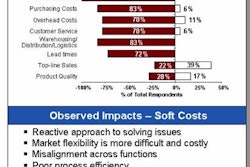New York — August 25, 2008 — Working capital optimization is a high priority for a majority of companies, and increasing numbers of organizations are looking to leverage both financial and supply chain strategies and technologies to aid these initiatives, according to a new research brief from Aberdeen Group.
Seventy-one percent of companies identify working capital optimization as a high priority, Aberdeen reported in a research brief based on a series of surveys conducted by Aberdeen on working capital optimization and supply chain finance.
The survey showed that 11 percent of companies faced supply chain disruptions in the past year due to lack of working capital, and 13 percent experienced disruptions due to suppliers' deteriorating financial situations.
Aberdeen said that the results of the research show that best-in-class companies in managing working capital metrics are able to obtain the following competitive advantages:
Aberdeen also found that best-in-class companies take proactive steps to integrate and automate their physical and financial supply chains to achieve end-to-end cost savings and process efficiencies.
"Today companies are increasing their already high focus on optimizing working capital, exploring both financial and supply chain strategies and technologies to aid in these initiatives," said Viktoriya Sadlovska, global trade and supply chain finance analyst at Aberdeen Group. "A strategic, forward-looking global corporation should think about its physical and financial supply chains holistically, integrating long-term end-to-end supply chain cost considerations with working capital concerns."
Sadlovska added that there is still a lot of value "trapped" in today's manually managed financial supply chains. "Process and financial efficiencies can be achieved by improving visibility into physical and financial supply chain milestones and documents, automation of order-to-cash and procure-to-pay processes, and rethinking of the old financing and payment practices with a company's trading partners," she said.
The report is being made available for free (registration necessary) by TradeCard, a provider of supply chain solutions, at www.tradecard.com/aberdeenresearch.
"In today's complex supply networks and n-tier supply chains, there is a significant opportunity to improve cash flow at each level," said Ken Mizera, vice president of business development at TradeCard. "Instead of one party being a winner and the other a loser in a transaction, working capital improvements can be made in a win-win environment."
Mizera suggested that significant opportunity arises when a third party becomes involved to provide financial services. "With the right set of tools and services in place, companies can collaborate with supply chain partners to determine what is best for the overall supply chain and use the correct levers to improve margin and cash flow simultaneously," he said.
TradeCard said that it helps retailers and brands source smarter and faster through a rapidly deployed network that enables the extended supply chain. The TradeCard Platform synchronizes financial transactions with physical events in the global supply chain to help customers automate trade transactions from purchase order to payment and chargebacks, the solution provider said.
Seventy-one percent of companies identify working capital optimization as a high priority, Aberdeen reported in a research brief based on a series of surveys conducted by Aberdeen on working capital optimization and supply chain finance.
The survey showed that 11 percent of companies faced supply chain disruptions in the past year due to lack of working capital, and 13 percent experienced disruptions due to suppliers' deteriorating financial situations.
Aberdeen said that the results of the research show that best-in-class companies in managing working capital metrics are able to obtain the following competitive advantages:
- Four day advantage in days payable outstanding compared to average companies;
- 19 day advantage in days inventory outstanding versus average companies;
- 6.5 times as likely as peers to have decreased end-to-end financing costs in the supply chain in the past year; and,
- 5 percentage points higher return on working capital versus average companies.
Aberdeen also found that best-in-class companies take proactive steps to integrate and automate their physical and financial supply chains to achieve end-to-end cost savings and process efficiencies.
"Today companies are increasing their already high focus on optimizing working capital, exploring both financial and supply chain strategies and technologies to aid in these initiatives," said Viktoriya Sadlovska, global trade and supply chain finance analyst at Aberdeen Group. "A strategic, forward-looking global corporation should think about its physical and financial supply chains holistically, integrating long-term end-to-end supply chain cost considerations with working capital concerns."
Sadlovska added that there is still a lot of value "trapped" in today's manually managed financial supply chains. "Process and financial efficiencies can be achieved by improving visibility into physical and financial supply chain milestones and documents, automation of order-to-cash and procure-to-pay processes, and rethinking of the old financing and payment practices with a company's trading partners," she said.
The report is being made available for free (registration necessary) by TradeCard, a provider of supply chain solutions, at www.tradecard.com/aberdeenresearch.
"In today's complex supply networks and n-tier supply chains, there is a significant opportunity to improve cash flow at each level," said Ken Mizera, vice president of business development at TradeCard. "Instead of one party being a winner and the other a loser in a transaction, working capital improvements can be made in a win-win environment."
Mizera suggested that significant opportunity arises when a third party becomes involved to provide financial services. "With the right set of tools and services in place, companies can collaborate with supply chain partners to determine what is best for the overall supply chain and use the correct levers to improve margin and cash flow simultaneously," he said.
TradeCard said that it helps retailers and brands source smarter and faster through a rapidly deployed network that enables the extended supply chain. The TradeCard Platform synchronizes financial transactions with physical events in the global supply chain to help customers automate trade transactions from purchase order to payment and chargebacks, the solution provider said.













